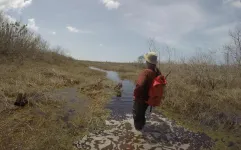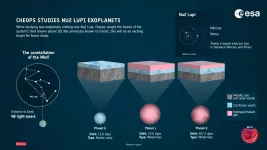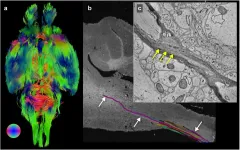(Press-News.org) A new paper published by an East Carolina University researcher in the Department of Coastal Studies shines light on the effect human-made infrastructure and natural topography has on coastal wetlands after major storm events.
In partnership with NASA and Florida International University, the study, led by assistant professor David Lagomasino, was published in the July edition of Nature Communications.
The study focused on the effects of Hurricane Irma, which struck Florida in 2017, and the damage it caused to the state's mangrove forests. The research team found that the forests suffered unparalleled dieback after the major hurricane.
Mangrove forests are often damaged after hurricanes, but Lagomasino said forests in Florida have shown great resiliency in the past due to their structure, position and species composition. After Hurricane Irma, the forests did not rebound at the same rate. Nearly 11,000 hectares -- a space the size of more than 24,000 football fields -- showed evidence of complete dieback following the storm.
For a resource that prevents more than $11 billion in annual property and flood damage in the state, that's a major concern, Lagomasino said.
"There have been significant storms in the past that have led to damage, but Irma seems to have caused one of the largest areas of dieback, at least in the satellite record," Lagomasino said.
After studying satellite and aerial footage of the region, the research team was able to pinpoint potential explanations for the dieback, including human-made obstacles.
"Human-made obstacles, as well as natural changes in topography, can impact the flow of water through an area," Lagomasino said. "Things like roads and levees can restrict or stop the flow of water between areas that were once connected. The lack of connection between the water can lead to extremes -- extreme dry conditions and extreme wet conditions, both of which can be stressful on wetland vegetation that thrives in more stable conditions."
The study noted that human-made barriers can lead to an increase in how long water stays on the surface, which can cause rapid degradation of fine root materials. Increased saltwater ponding may occur when storm surge is high and barriers obstruct water flow.
These results are not only key for future storm planning in Florida, but other coastal states like North Carolina, Lagomasino said.
"What we have learned in Florida can be useful to North Carolina and other coastal regions," Lagomasino said. "Our results indicate that the elevation of the landscape, the connectivity of water across the landscape, and the height of storm surge can indicate vulnerable areas. In other words, low elevation areas that are disconnected or do not have the capability to drain after being flooded are more susceptible to long-term damage.
"This is useful for understanding the resilience of coastal forests and wetlands in North Carolina and may also be important in predicting urban areas that may also be less resilient to these extreme events."
The study suggested changes that can be made to improve coastal resiliency in the future when facing severe weather events, including:
Adding new metrics that account for storm surge and geology to the traditional hurricane rating system;
Establishing field research stations in low-lying areas to help identify underrepresented physical and biological processes in vulnerable regions;
Performing regular coastal remote sensing surveys to monitor drainage basins and improve water connectivity; and
Improving freshwater flow to help create new tidal channels.
"We hope that the information from our research will help improve the recovery process after storms," Lagomasino said. "If these areas can be identified ahead of time, then the disaster response can address issues in hard-hit areas much faster or minimize the impact beforehand.
"The big takeaway here is that intense winds do a lot of damage during hurricanes. However, the intensity of damage does not necessarily coincide with the ability of the system to recover over time. Other factors, like slight changes in the elevation of the coastal landscape and storm surge, play a significant role in how the ecosystem recovers or does not recover after the initial damage. Having these factors in mind prior to hurricane season can help lessen long-term impacts in vulnerable communities."
INFORMATION:
LMU biologists have shown that 'supervisor' and 'motivator' proteins are required to enable a third factor to perform its function in photosynthesis.
Plants, algae and cyanobacteria need only three ingredients for the synthesis of sugars via the process of photosynthesis - carbon dioxide, water and sunlight. However, the operation is far more complicated than this simple list of ingredients might suggest. Prof. Dr. Dario Leister and research group in the Department of Biology I at LMU are analyzing the complex regulation of photosynthesis. Their latest findings shed light on the roles of three proteins, named PGRL1, PGRL2 and PGR5, which participate in the control of one of the two subsystems of the photosynthetic apparatus. PGRL2 itself was first discovered in the course of the ...
COLUMBUS, Ohio - The most narcissistic U.S. presidents since 1897 preferred to instigate conflicts with other great power countries without seeking support from allies, a new study suggests.
Results showed that of the presidents measured, those highest in narcissism - including Lyndon B. Johnson, Teddy Roosevelt and Richard Nixon - were about six times more likely to initiate a dispute with another great power in any given year than a president with average levels of narcissism.
The inclination to "go it alone" in international disputes fits with the desire ...
Public opinion surveys could be used more widely to understand regional variation in vaccine hesitancy, experts have recommended.
The research shows vaccine uptake rates for childhood vaccines are significantly lower in regions where hesitancy observed in mass public opinion surveys is more pronounced.
This data is often not widely available, which makes it challenging for experts to analyse the links between attitudes and real-world behaviour. The study says this data should be used by public health officials to understand where vaccines are more likely to be rejected, and who should be the target of information campaigns.
The research published in the journal ...
While exploring two exoplanets in a bright nearby star system, ESA's exoplanet-hunting Cheops satellite has unexpectedly spotted the system's third known planet crossing the face of the star. This transit reveals exciting details about a rare planet "with no known equivalent", say the researchers.
The discovery is one of the first results from ESA's Cheops (CHaracterising ExOPlanet Satellite), and the first time an exoplanet with a period of over 100 days has been spotted transiting a star that is bright enough to be visible to the naked eye.
Named Nu2 Lupi, this bright, ...
PITTSBURGH, June 28, 2021 - It was a nagging mystery: A rare-disease expert at UPMC Children's Hospital of Pittsburgh had found a successful treatment for two of the deadliest symptoms of one of the more common classes of rare diseases diagnosed by newborn screenings, but one symptom--painful episodes of muscle breakdown that land victims in intensive care--persisted.
Today, the scientists announce in the journal Clinical & Translational Immunology that they've gotten to the bottom of the self-destructive syndrome and have a good lead on a treatment.
"These episodes looked a lot like inflammatory ...
An incredibly rare hybrid warbler with mismatched color patterns has allowed researchers to disentangle the genetic drivers of two traits that usually come as a package deal--the black face mask and the black throat patch in blue-winged and golden-winged warblers. A new study describing the peculiar bird and pinpointing the location in the genome that controls the face mask and throat patch appears online in the journal Ecology.
"Golden-winged warblers have both a black face mask and a black throat patch, while blue-winged warblers have neither," said Marcella Baiz, postdoctoral researcher at Penn State and first ...
Some exoplanet searches could be missing nearly half of the Earth-sized planets around other stars. New findings from a team using the international Gemini Observatory and the WIYN 3.5-meter Telescope at Kitt Peak National Observatory suggest that Earth-sized worlds could be lurking undiscovered in binary star systems, hidden in the glare of their parent stars. As roughly half of all stars are in binary systems, this means that astronomers could be missing many Earth-sized worlds.
Earth-sized planets may be much more common than previously realized. Astronomers working at NASA Ames Research Center have used the twin telescopes of the international Gemini Observatory, a Program of NSF's NOIRLab, to determine that many planet-hosting ...
WASHINGTON, D.C.--A new study in Annals of Emergency Medicine highlights the importance of protecting physician residents--early-career doctors still in training--and emergency care teams from incidents of physical or verbal abuse.
The survey of 123 physicians, residents, and staff in one emergency department found that 78 percent of all health care workers experienced a violent assault in the prior 12 months, including more than one in five (22 percent) emergency physician residents. Eighty-nine percent of residents experienced verbal assault by a patient in the prior 12 months, compared to 80 percent of other health care workers.
"Violent ...
Philadelphia, June 28, 2021--Researchers at Children's Hospital of Philadelphia (CHOP) have discovered that a specific type of lung cell exhibits unconventional immune properties and may contribute to the outcome of respiratory viral infections. The researchers focused on type II alveolar (AT2) cells, which are non-immune cells of the lung that are critical for basic lung health and tissue repair after lung injury. They found that AT2 cells express high levels of major histocompatibility complex II (MHC-II), an important immune system trigger, and that AT2 MHC-II expression appears to confer an appreciable ...
Researchers at the University of Chicago and the U.S. Department of Energy's (DOE) Argonne National Laboratory have leveraged existing advanced X-ray microscopy techniques to bridge the gap between MRI (magnetic resonance imaging) and electron microscopy imaging, providing a viable pipeline for multiscale whole brain imaging within the same brain. The proof-of-concept demonstration involved imaging an entire mouse brain across five orders of magnitude of resolution, a step which researchers say will better connect existing imaging approaches and uncover new details about the structure of the brain.
The advance, which was published on June 9 in NeuroImage, will allow ...


